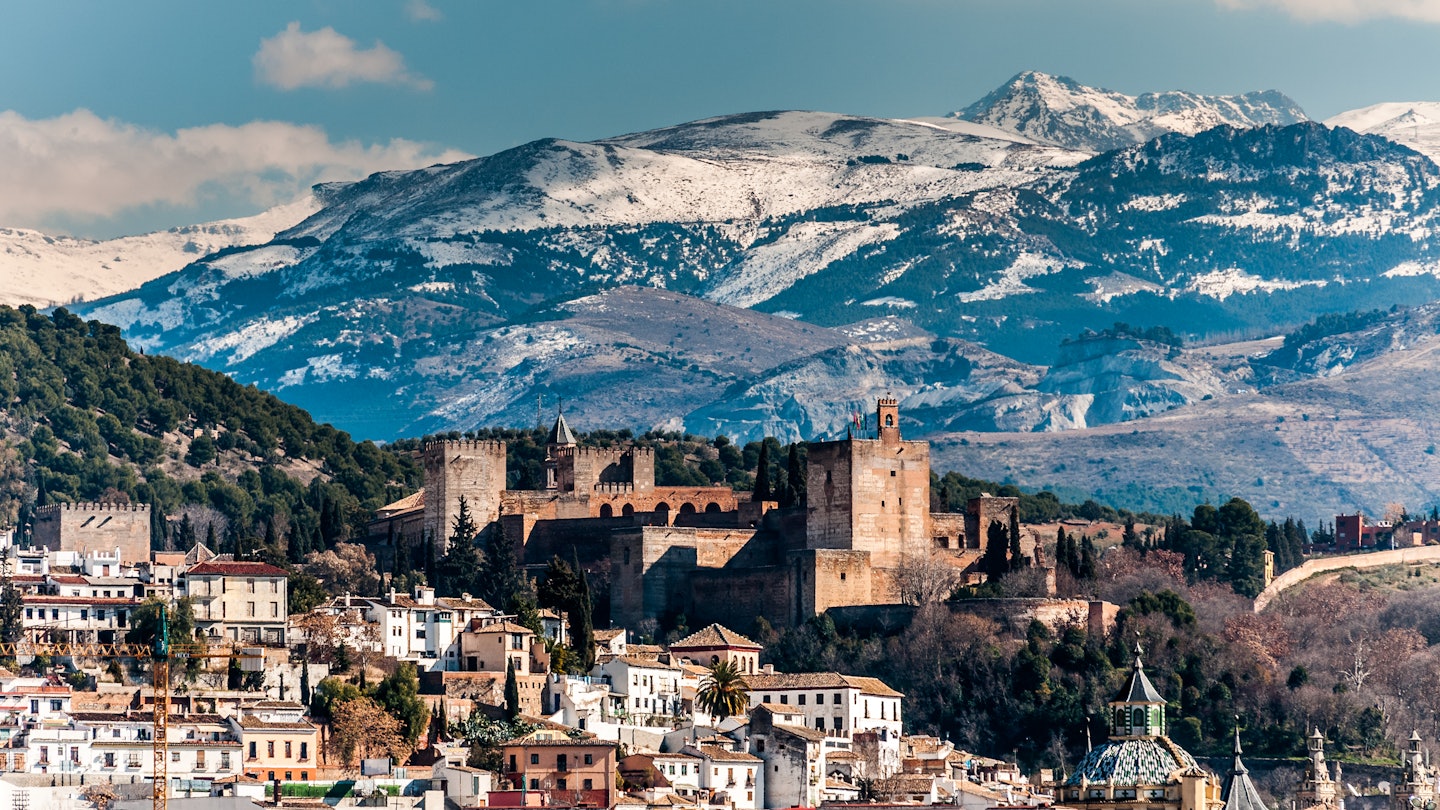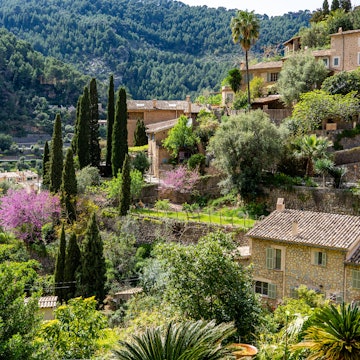

Granada. iStock/Getty Images
Cultured, creative Granada's storied past centers on the Alhambra, one of the world’s greatest architectural wonders. To the Moors, it was a paradise on Earth; to the Reyes Católicos (Catholic Monarchs) who succeeded them, Granada became the seed from which a global empire grew.
The legacy of the city's historic diversity remains a top draw for a first visit to Granada. Neighborhoods of winding cobblestone streets once home to Jewish (El Realejo), Roma (Sacromonte) and Muslim (the Albaicín) communities wait to be explored. But you can also fill up a weekend itinerary with attractions for gourmets, history buffs and fans of street art and all things musical and literary.
Make the most of your trip to Granada with these top things to do.

1. Take in architectural perfection at the Alhambra
Granada is best known for the astonishing Alhambra, a majestic hilltop stronghold consisting of ornately decorated palaces (Palacios Nazaríes), robust fortifications (the Alcazaba) and graceful gardens (the Generalife). As you wander through the lavishly stuccoed rooms of the palace and courtyards anchored by burbling marble fountains, it’s easy to imagine the emirs reclining in the shade, savoring life’s finer things. That was the underlying philosophy behind such exquisite buildings: that life is transitory and best appreciated in the present. You’ll feel it the minute you enter.
Planning tip: Entry to the Palacios Nazaríes is by timed ticket; we recommend booking well in advance given the site’s popularity and picking a morning slot to beat the heat and the crowds.
2. Visit interred royals at the Capilla Real
Although nothing that the conquering Reyes Católicos built after their 1492 conquest of the city rivals the Alhambra, the Capilla Real comes closest. While the Moorish palace celebrated life, this ornate post-Reconquista royal chapel is a place of final rest. Within the Gothic chapel, which adjoins the Catedral de Granada, the ornate marble tombs of the monarchs Ferdinand and Isabella lie behind a protective wrought iron barrier. Most of the royal remains are boxed up in lead coffins in the crypt below.

3. Set out on a tapas crawl
A culture of tapas – specifically, free tapas – lives on in Granada. The practice of providing a small plate of food with every drink purchase was once widespread in Spain, yet now it’s almost exclusively limited to Granada and its environs. Stalwarts like Bar Poë even have a menu, and patrons can choose from over 10 dishes, including estofado de carne (piri-piri pork stew) and ensalada de garbanzos (chickpea salad).
If you want local expertise, the knowledgeable guides of Granada Tapas Tours take small groups to less familiar spots.
Planning tip: There are places offering free tapas throughout the city, although in Realejo, you’ll find plenty of traditional-style bars, such as Los Diamantes on Calle Navas. A useful phrase to remember is “vamos a tapear” (loosely, “let’s go tapas barhopping”).
4. Add too much sugar to your mint tea at a tetería
You won’t find clusters of teterías (teahouses) in most other Spanish cities – they’re a remnant of the Moorish culture that the emirs left behind when Boabdil left for the Sierra Nevada mountains. Underscoring this link are the arabesque flourishes at Tetería Dar Ziryab and the excellent Middle Eastern cuisine (try the baba ghanoush) at Restaurante Tetería Palmira. Locals load up on mint tea – skip the milk but go heavy on the sugar – poured into glasses from stainless steel pots.
Planning tip: The densest concentration of teterías is around the intersection of Calles Elvira and Calderería Nueva, two blocks east of the cathedral.

5. Discover contemporary street art in medieval alleys
Medieval Granada is the hometown of one of Europe’s most renowned street artists: Raúl Ruiz, better known as El Niño de las Pinturas, who lives in the city, working in the tradition of graffiti artists. His surprisingly sweet large-scale murals depicting children, historical figures and granadinos (people of Granada) are visible all over: in narrow alleys (especially in the Realejo neighborhood), along the banks of the Río Genil and on the sides of buildings in every corner of town. Whether you set off on an organized tour to take in his best-known works or simply come across one of the vivid displays by serendipity, expect a lively and surprising complement to Granada’s historic vibe.
Detour: Street art in Granada isn't limited to Ruiz's work. No matter where you go in the city, you'll likely encounter beautiful illustrations in unexpected places, like these ancient ceramic utensils painted on the shutter of a closed pharmacy (above).
6. Wax lyrical about Lorca’s Granada
Nobody has encapsulated the alluring landscapes and haunting culture of Andalucía quite like Federico García Lorca. And a little sliver of his “Parched land, quiet land, of immense nights” can be explored at Huerta de San Vicente. It was here – at his summer house on the western edge of the city, surrounded by bucolic poplars, palms and ponds – that the indomitable early-20th-century writer composed many of his finest poems and plays.
Detour: For a deeper dive into Lorca lore, head out to Museo Casa Natal in the village of Fuente Vaqueros, 17km (13 miles) from Granada. This is where the poet was born and spent his early childhood.

7. Take in one of Spain’s finest views
The Alhambra gloriously dominates just about every vista from the Albaicín toward the snowcapped Sierra Madre peaks. Complete a late afternoon stroll of its narrow cobblestone streets at a mirador (lookout point) in time for sunset. The most impressive view is from Mirador San Nicolás. Many visitors to Granada book accommodations in the Albaicín just so they can start and end their day with this vista.
Planning tip: The streets in this area include steep sections and lots of steps, so pack appropriate footwear. Hotels higher up the hill, north of the Darro River, offer the best views; good, well-priced options include Casa Bombo and Hotel Santa Isabel la Real.
8. Notice the blend of architectural styles in Mudéjar buildings
Formerly a mosque, the Parroquia de San Gil y Santa Ana is a fine example of the religious and architectural repurposing typical of Andalucía’s historic buildings. While the church's baroque style is immediately evident, look up to see the exquisitely carved wooden artesonado – these ceilings of interlaced beams with decorative insertions are derived from the Mudéjar style. Other fascinating specimens of this era include the Corral del Carbón, so named for its former use as a coal warehouse; it was originally a 13th-century caravanserai (inn). Nearby, the Palacio de la Madraza, next to the cathedral, has a Spanish baroque exterior that conceals the Mudéjar stucco within.

9. Attend a flamenco performance in a Sacromonte cave
Romani heritage is in fine evidence throughout the Sacromonte neighborhood, in Granada’s northeast. Many of the oldest homes were built in the naturally abundant caves of these Sierra Nevada foothills – caves whose acoustics accentuate the emotive nature of flamenco. Today, dozens of nightly shows in Sacromonte feature this form, called granaína, including at Zambra María la Canastera and Cueva de la Rocio.
Planning tip: There are plenty of great places that aren't caves to catch a flamenco performance elsewhere in Granada. Some of these theaters, known as tablao, provide dinner and a show (such as Tablao Flamenco La Alboreá); others focus purely on the art.
10. Brush up on Inquisition history at Palacio de los Olvidados
For a long time, the Inquisition remained a shameful and unacknowledged chapter of Spain’s past. These days, it can still feel like an unresolved issue, though museums such as the Palacio de los Olvidados, with its displays of torture devices common during the era, go some way toward examining the period of deadly extremism that followed the overthrow of the Moors in Granada.
11. Shop for rare ceramics at Fajalauza
If you’re planning to explore the upper reaches of the Albaicín, be sure to stop by Fajalauza. In operation since 1517, the family-run factory of granaína ceramics has lasted through dozens of generations (even as rumors of its imminent closure persist). The exhibition and sales room is an ideal place to find a unique, hand-painted souvenir of an unforgettable city.
















